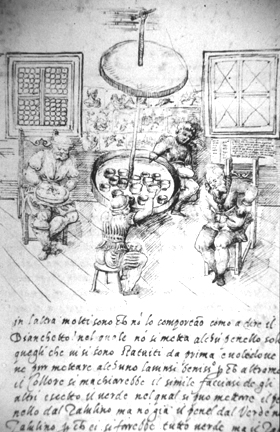In 1556, Cipriano Piccolpasso, an amateur potter and resident of Castel Durante wrote 'The Three Books of the Potter's Art, the first treatise on pottery making published in Europe. In this early work, he details the methods of preparing clay, forming pottery on the wheel, glaze preparation and decorating, and firing procedures. The illustration on the right is taken from this book. Three majolica painters are seen at work assisted by a helper or apprentice, who is seated with his back to us, grinding pigments for use by the artists. The painter at left is working on a plate, the one at right, a vase, and the one at the rear reaches across the table for a bowl of pigment to fill his brush. The illustration contains several interesting details, such as the circular table suspended from the ceiling. It is similar to a 'lazy susan,' a round, turntable counterbalanced with another disk above. This way, each of the painters can access the color he wants just by turning the table. Behind the painters, on the wall, are sketches of designs to guide them as they paint. The stained glass windows allow light to enter, and below the window on the right are posted instructions for the painters. Piccolpasso is very specific with his instructions, and gives a formula for preparing the opaque, white glaze that is to be used as the painting base.This white glaze is called 'bianchi,' appropriately enough, as this word means 'white' in Italian. (Note the word Bianchetto, the first word in the second line of the text, referring to the glaze). Piccolpasso recommends the following mineral oxides to use: cobalt for blues, copper for greens, tin oxide for white highlights, antimony for yellow, antimony plus iron for orange, and manganese for purples. As for the ever-elusive red, Piccolpasso states that 'as yet, there is no substance that reliably gives red.' He does mention, rather skeptically, that Armenian Bole (that same as used on Iznik ware in Turkey), has been tried in Faenza, but that it is not reliable. He details how to apply the glaze and pigments, and recommends firing the ware in saggars to protect it from the ash of the fire.
Other illustrations show potters at work on foot-powered treadle wheels, throwing plates, vases, bowls, and albarelli. Another section, devoted to firing, has an illustration of a wood-fired, updraft kiln made of brick in the process of being fired. The fireman holds his hand up, shielding his face against the heat of the kiln as he opens the spyhole to gauge the progress of the firing. It is a scene familiar to every potter. Buckets of water and a well are nearby, testifying to the dangers involved. So many fires that burned whole parts of cities were attributed to potter's kilns, that local pottery towns passed laws that forbad potters from bringing the cords of firewood into the town limits until the day just before the firing to minimize the fire danger in having large supplies of wood nearby.

Majolica painters at work, Illustration from 'The Three Books of the Potter's Art,' by Cipriano Piccolpasso, Castel Durante, 1556 CE


